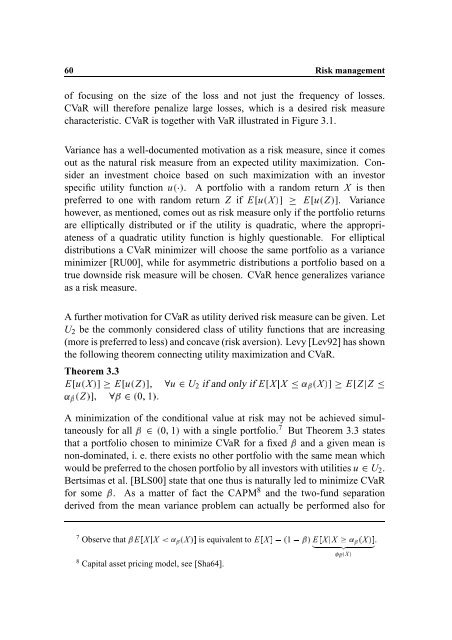Hedging Strategy and Electricity Contract Engineering - IFOR
Hedging Strategy and Electricity Contract Engineering - IFOR
Hedging Strategy and Electricity Contract Engineering - IFOR
Create successful ePaper yourself
Turn your PDF publications into a flip-book with our unique Google optimized e-Paper software.
60 Risk management<br />
of focusing on the size of the loss <strong>and</strong> not just the frequency of losses.<br />
CVaR will therefore penalize large losses, which is a desired risk measure<br />
characteristic. CVaR is together with VaR illustrated in Figure 3.1.<br />
Variance has a well-documented motivation as a risk measure, since it comes<br />
out as the natural risk measure from an expected utility maximization. Consider<br />
an investment choice based on such maximization with an investor<br />
specific utility uS V function . A portfolio with a r<strong>and</strong>om return X is then<br />
preferred to one with r<strong>and</strong>om return Z if uS XV E uS ZV E . Variance<br />
however, as mentioned, comes out as risk measure only if the portfolio returns<br />
are elliptically distributed or if the utility is quadratic, where the appropriateness<br />
of a quadratic utility function is highly questionable. For elliptical<br />
distributions a CVaR minimizer will choose the same portfolio as a variance<br />
minimizer [RU00], while for asymmetric distributions a portfolio based on a<br />
true downside risk measure will be chosen. CVaR hence generalizes variance<br />
as a risk measure.<br />
A further motivation for CVaR as utility derived risk measure can be given. Let<br />
U 2 be the commonly considered class of utility functions that are increasing<br />
(more is preferred to less) <strong>and</strong> concave (risk aversion). Levy [Lev92] has shown<br />
the following theorem connecting utility maximization <strong>and</strong> CVaR.<br />
uS XV uS G R S ZV XV d<br />
d R S ZV G 0G c 1V S .<br />
Theorem 3.3<br />
E E u U 2 if <strong>and</strong> only if E X X E Z Z<br />
A minimization of the conditional value at risk may not be achieved simultaneously<br />
for c S 0G 1V all with a single portfolio. 7 But Theorem 3.3 states<br />
that a portfolio chosen to minimize CVaR for a c fixed <strong>and</strong> a given mean is<br />
non-dominated, i. e. there exists no other portfolio with the same mean which<br />
would be preferred to the chosen portfolio by all investors with utilities u U 2 .<br />
Bertsimas et al. [BLS00] state that one thus is naturally led to minimize CVaR<br />
for c some . As a matter of fact the CAPM 8 <strong>and</strong> the two-fund separation<br />
derived from the mean variance problem can actually be performed also for<br />
7 Observe n Eo that p X qsrut>v Xw=x X is equivalent Eo Xxzy{v to y|n}w 1 o E p X ~rut€v Xw=x X<br />
X„ lƒ‚<br />
8 Capital asset pricing model, see [Sha64].<br />
.
















